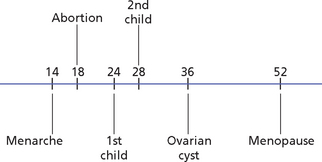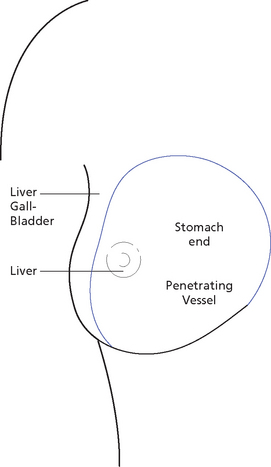 WOMEN’S SYMPTOMS
WOMEN’S SYMPTOMS
HOW WE ASK
When asking about a woman’s gynaecological history, we should always start from the beginning by enquiring about the conditions of her cycle 2 years after menarche (because it is common for the cycle to be irregular for the first 2 years before it settles down).
THE GYNAECOLOGICAL HISTORY
Women’s gynaecological history may sometimes be complicated; for example, a woman may have used the contraceptive pill or the coil for some years, or she may have had two children with possibly one or more miscarriages or terminations in between. In such cases, it is useful to draw a diagram illustrating clearly the ages at which such events occurred. As an illustration, Figure 46.1 shows the gynaecological history of a woman whose menarche occurred at 14 and who had an abortion at 18, a child at 24 and 28, an ovarian cyst at 36 and the menopause at 52.

Fig. 46.1 Diagram of gynaecological history
If the woman’s cycle is irregular and characterized by discharges or mid-cycle pain or discharge, it is also useful to draw a diagram illustrating clearly at what part of the cycle such events take place. As a way of illustration, Figure 46.2 shows the menstrual cycle of a woman whose period lasts 7 days and who experiences mid-cycle pain and premenstrual tension with breast distension.

Fig. 46.2 Diagram of menstrual cycle
Some women may complain of prolonged menstrual bleeding whereas, in fact, they may suffer from mid-cycle bleeding. Case history 46.1 illustrates this.
Gynaecological events affecting diagnosis
The answers to questions regarding regularity of cycle, amount of bleeding, colour of menstrual blood, pain, etc., are unreliable if the woman is on the Pill or has an intrauterine device. The Pill regularizes the periods, makes them usually scanty and less painful, and often prevents clotting; the intrauterine device generally makes the periods heavier and more painful. In such cases, it is important to ask the patient what her menstrual cycle was like before she began using these forms of contraception.
BREAST SYMPTOMS
The breasts in women are influenced primarily by the Stomach channel, which controls the main tissues of the breast and the lactiferous ducts; the Liver channel influences the nipple but also, together with the Gall-Bladder channel, the lateral side of the breast. The Penetrating Vessel also influences the lactiferous ducts and the connective tissues of the breast, which, in Chinese medicine, would be classified as ‘Membranes’ (Huang). The Muscle channels of the Gall-Bladder, Heart and Pericardium flow over the breast. (See Fig. 46.3 and also Fig. 12.1 on p. 121 illustrating the channels coursing through the breast.)

Fig. 46.3 Organs influencing areas of the breast
Breast lumps
Observation, Chapter 12; Palpation, Chapter 51; Symptoms and Signs, Chapter 88
A common pathology of the breasts in women is the development of lumps.
The age of the patient may give a rough indication of which is the most likely of these three pathologies because fibroadenomas are more common between the ages of 20 and 30, cysts between 30 and 50 and carcinoma from 50 onwards; of course, these are only general statistical indications which always have exceptions in practice.
Box 46.1 summarizes patterns underlying breast lumps.
MENSTRUATION
When asking about menstruation, we should ask about the following aspects systematically:
When asking questions about the menstrual cycle, I always ask the woman how her periods were about 2 years after the menarche (remember that it is normal for the period to be somewhat irregular for 2 years after menarche). This is important because it gives us an idea of the woman’s constitutional menstrual cycle, eliminating the influence of subsequent gynaecological events (e.g. pregnancy, childbirth, miscarriage, abortion, contraception, etc).
Amount of bleeding
Symptoms and Signs, Chapter 84
Case history 46.3 illustrates a pattern underlying heavy periods.
Box 46.3 summarizes the patterns underlying abnormal amounts of bleeding.
Colour
Observation, Chapter 20; Symptoms and Signs, Chapter 84
The colour of the menstrual blood varies slightly during the period. In general, it is usually dark red, being lighter at the beginning, deep red in the middle, and pinkish at the end of the period. Box 46.4 summarizes the main areas of questioning and patterns with regard to colour.
Consistency
Observation, Chapter 20; Symptoms and Signs, Chapter 84
The normal flow does not coagulate and there are no clots; the blood is neither dilute nor thick. Box 46.5 summarizes the main areas of questioning and patterns with regard to the consistency of menstrual blood.
Cycle
Symptoms and Signs, Chapter 84
Box 46.6 summarizes the patterns underlying menstrual cycle irregularites.
Pain
Symptoms and Signs, Chapter 84
Time of pain
Pain before the period may be caused by stagnation of Qi or stasis of Blood; the latter is typically relieved by the onset of the period. Pain during the period is generally due to Blood-Heat or Blood stasis. If there is pain after the period then this may be a result of Blood deficiency.
Premenstrual symptoms
Symptoms and Signs, Chapter 85
Premenstrual tension may also be caused by Deficiency, and primarily Liver-Blood deficiency, Liver- and Kidney-Yin deficiency, Spleen- and Kidney-Yang deficiency, and Spleen-Qi deficiency with Dampness. In Deficiency premenstrual tension manifests primarily with depression, crying, lack of motivation, feelings of heaviness, tiredness and lassitude, and only a mild irritability.
Box 46.8 summarizes patterns underlying premenstrual symptoms.
PREGNANCY AND CHILDBIRTH
Fertility
Symptoms and Signs, Chapters 86 and 89
Infertility can be due to many different deficient or excess conditions. These are:
Case histories 46.7–46.9 illustrate some patterns underlying problems with fertility.





